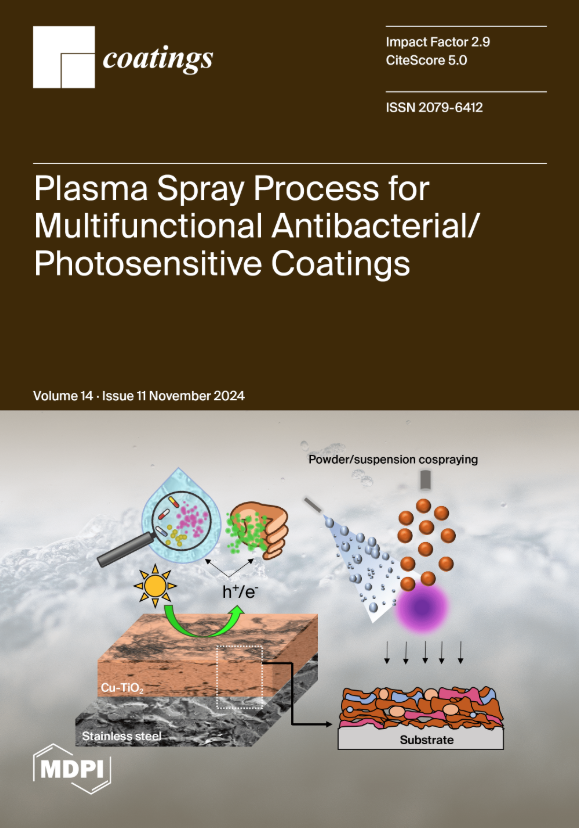Fabrication of Corrosion-Resistant Superhydrophobic Coatings and Impermeable Porous Structures Using Fluorinated Microemulsions Containing Thermally Decomposable Surfactants
IF 2.8
3区 材料科学
Q2 MATERIALS SCIENCE, COATINGS & FILMS
引用次数: 0
Abstract
In this work, a series of fluorinated microemulsions were synthesized using thermally decomposable N-dodecyl-N,N-dimethylamine N-oxide (LDAO) as surfactant. Then, polybutylene terephthalate nonwoven fabrics (PBT) were coated with microemulsion and heat-treated. Superhydrophobic and oil-repellent modified PBT with WCA (water contact angle) of about 152°, a sliding angle of about 2.1°, and oil repellency grade of 8 were prepared. The effect of surfactants on the surface wettability of hydrophobic materials was analyzed by TG-DTA, XPS, and WCA tests. The results show that surfactants decrease the WCA of hydrophobic materials, but LDAO can eliminate this effect by heat treatment. The anti-corrosion and permeability of LDAO coatings were compared with those of conventional fluorinated coatings through degradation and anti-permeability tests. It was shown that the LDAO fluorinated superhydrophobic coating is more resistant to corrosion by chemical solutions and significantly improves the impermeability of porous materials. Anti-fouling and self-cleaning tests showed excellent anti-fouling and self-cleaning properties on several common substrate surfaces modified with LDAO fluorinated microemulsions. It is expected that these new LDAO fluorinated microemulsions have promising applications in the preparation of corrosion-resistant surfaces and impermeable structures.利用含可热分解表面活性剂的氟化微乳液制造耐腐蚀超疏水涂层和不透水多孔结构
本研究以可热分解的 N-十二烷基-N,N-二甲胺 N-氧化物(LDAO)为表面活性剂,合成了一系列含氟微乳液。然后,在聚对苯二甲酸丁二醇酯无纺布(PBT)上涂覆微乳液并进行热处理。制备出了超疏水和憎油改性 PBT,其 WCA(水接触角)约为 152°,滑动角约为 2.1°,憎油等级为 8 级。通过 TG-DTA、XPS 和 WCA 测试分析了表面活性剂对疏水材料表面润湿性的影响。结果表明,表面活性剂会降低疏水材料的 WCA,但 LDAO 可以通过热处理消除这种影响。通过降解和抗渗透性测试,比较了 LDAO 涂层与传统含氟涂层的抗腐蚀性和抗渗透性。结果表明,LDAO 含氟超疏水涂层更能抵抗化学溶液的腐蚀,并能显著提高多孔材料的抗渗性。防污和自清洁测试表明,用 LDAO 氟化微乳液改性的几种常见基材表面具有优异的防污和自清洁性能。预计这些新型 LDAO 含氟微乳液在制备抗腐蚀表面和防渗结构方面具有广阔的应用前景。
本文章由计算机程序翻译,如有差异,请以英文原文为准。
求助全文
约1分钟内获得全文
求助全文
来源期刊

Coatings
Materials Science-Surfaces, Coatings and Films
CiteScore
5.00
自引率
11.80%
发文量
1657
审稿时长
1.4 months
期刊介绍:
Coatings is an international, peer-reviewed open access journal of coatings and surface engineering. It publishes reviews, research articles, communications and technical notes. Our aim is to encourage scientists to publish their experimental and theoretical results in as much detail as possible. There is no restriction on the length of the papers. Full experimental and/or methodical details must be provided. There are, in addition, unique features of this journal:
* manuscripts regarding research proposals and research ideas will be particularly welcomed
* electronic files or software regarding the full details of the calculation and experimental procedure - if unable to be published in a normal way - can be deposited as supplementary material
 求助内容:
求助内容: 应助结果提醒方式:
应助结果提醒方式:


